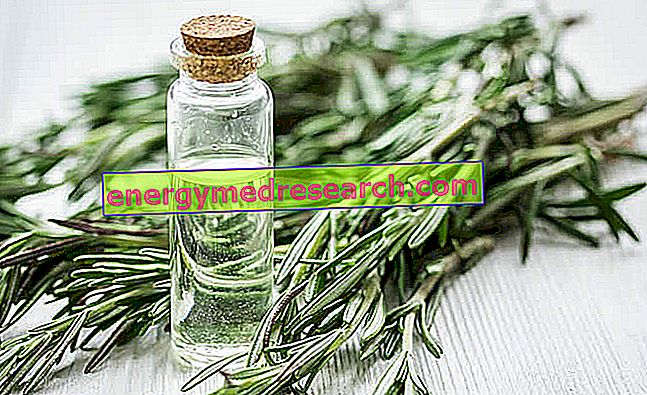What is that
Rosemary essential oil is a product obtained from the leaves, fresh twigs and flowering tops of Rosmarinus officinalis, a perennial shrub belonging to the Labiatae family.

Equipped with numerous properties, rosemary essential oil is used in various fields, from cosmetics to aromatherapy.
Curiosity
Rosemary is a plant around which numerous myths and legends circulate. Among these we recall that according to which the flowers of the plant, initially white in color, became blue following contact with the mantle of the Virgin Mary. Not surprisingly, the English name of rosemary is "Rosemary" which derives from "Rose of Mary" (the rose of Mary).
Features and Composition
Characteristics and Chemical Composition of Rosemary Essential Oil
Rosemary essential oil is obtained by steam distillation of the leaves, fresh twigs and / or flowering tops of the homonymous plant (however, the Italian Official Pharmacopoeia states that this oil is prepared only with fresh leaves and twigs ).
Rosemary essential oil is a colorless or pale yellow liquid, with a characteristic, strong and penetrating smell, in some cases pungent, given by the substances present in it.
More in detail, the main chemical components of rosemary essential oil are:
- 1, 8-cineole (in a concentration varying from 20 to 50%), probably better known as eucalyptol;
- Alpha-pinene (in concentrations varying from 15 to 25%);
- Camphor (in concentrations of 10-25%);
- Verbenone;
- camphene;
- borneol;
- Bornil acetate;
- Beta-caryophyllene;
- p-cymene;
- Limonene;
- linalool;
- myrcene;
- Alpha-terpineol.
Did you know that ...
There are different chemotypes of rosemary essential oil, which differ, precisely, in the chemical composition of the product in question.
The chemotype (abbreviated "ct.") Usually represents the component most present in the essential oil.
Depending on the chemotype, the properties of a given essential oil may vary, therefore, the indications of use may also be different.
As far as rosemary essential oil is concerned, we recall the verbenone chemotype and the cineol chemotype. The properties of these two chemotypes are similar, but the essential oil of rosemary ct. verbenone appears to be more delicate and less stimulating than the ct. cineol.
Property
Properties of Rosemary Essential Oil
Rosemary essential oil has many properties, which allow it to be used in the treatment of a wide variety of disorders.
In detail, following its oral intake, the essential oil of rosemary exerts both an antispastic activity on the digestive tract and on the bile ducts, and a choleretic activity; while if applied externally, this oil is able to exert an analgesic and slightly revulsive action.
Rosemary essential oil has also shown to possess antioxidant, antibacterial, antiviral and antiparasitic properties, to which are added dermo-purifying, astringent, deodorising and toning properties.
uses
Uses of Rosemary Essential Oil
Given its many properties, the problems that can be treated with rosemary essential oil are many. This oil can be used both externally and internally.
Generally, when used externally, in order to avoid the onset of irritation, rosemary essential oil is not used pure, but diluted inside various types of cosmetic products (such as creams, oils, shampoos, etc.). Similarly, when taken orally, rosemary essential oil should be previously diluted, for example, in a teaspoon of honey or in a sugar cube.
Digestive and hepatobiliary disorders
Rosemary essential oil has a spasmolytic activity at the level of the smooth muscle of the small intestine and at the level of the bile ducts, to which is added a choleretic action. For this reason, this oil is used internally for the treatment of digestive disorders. In these cases, it is usually recommended to take 1-3 drops of essential oil a day to be dissolved in a teaspoon of honey.
Skin disorders
By virtue of its antimicrobial, dermo-purifying and astringent properties, rosemary essential oil can be useful in case of skin and greasy hair. In this regard, it is sufficient to add 10-20 drops of product to about 50 ml of face cream, shampoo or facial and body cleansers, provided they are neutral.
In the case of greasy hair, in addition to adding oil to neutral shampoo, it is also possible to prepare masks suitable for the treatment of this type of hair (for more information: DIY Hair Masks).
In the case of acne or pimples, however, it may be useful to apply 2-3 drops of essence on a cotton pad, with which you will then have to dab the affected area.
Finally, rosemary essential oil can be useful to perform massages on the scalp in order to promote hair growth. Indeed, a clinical study conducted on this subject has shown that the use of rosemary essential oil in patients with androgenetic alopecia is able to promote hair regrowth in a similar way to a 2% minoxidil solution.
Rheumatism
Thanks to its analgesic and slightly revulsive properties, performing massages with special oils, ointments or ointments based on rosemary essential oil (usually present in concentrations of 6-10%) can be useful to counter rheumatic pains.
fumigations
Since it has balsamic properties (especially thanks to the content of 1, 8-cineol), the essential oil of rosemary can be used to perform fumigations in case of colds, flu and sinusitis. In these cases, it is recommended to dissolve 5-6 drops of essential oil in one liter of hot water, but not boiling.
Aromatherapy
In aromatherapy, rosemary essential oil is used to stimulate memory and improve concentration. In the same way, always in the field of aromatherapy, the oil in question finds employment in case of nervous tension and performance anxiety.
Food industry
The antioxidant and antimicrobial activities of rosemary essential oil are also used in the food industry, where this product is used as a preservative and additive (approved, moreover, by the FDA - Food and Drug Administration of United States).
Side effects
If properly used, rosemary essential oil should not cause any side effects. However, in some cases, skin irritation and allergic contact dermatitis may occur in sensitive individuals.
Contraindications
The use of rosemary essential oil is contraindicated in the following cases:
- In individuals with known hypersensitivity to the same essential oil of rosemary or to any of its components;
- In people with epilepsy;
- In patients with hypertension;
- In pregnancy (since rosemary essential oil could exert an abortive effect).



